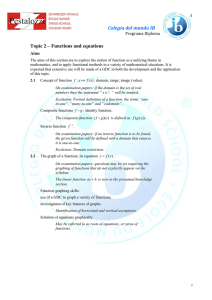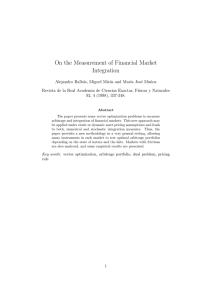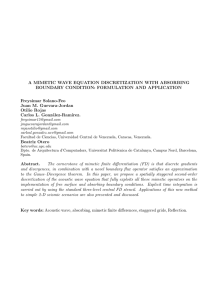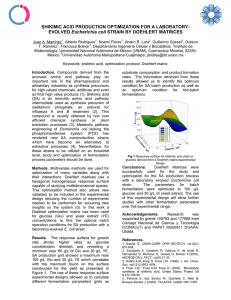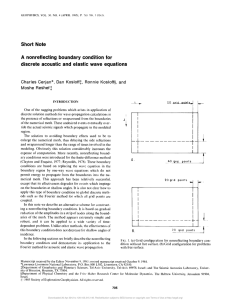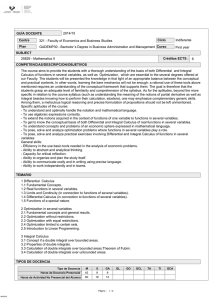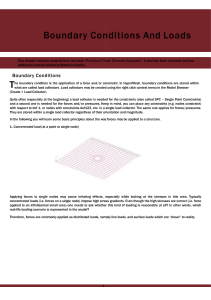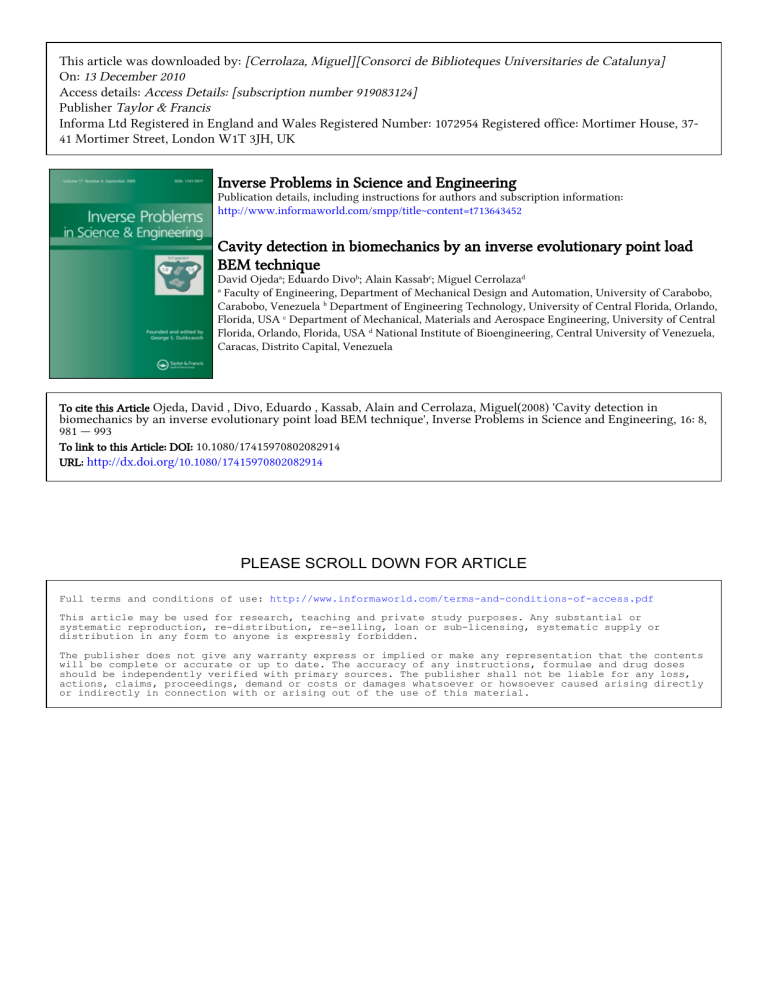
This article was downloaded by: [Cerrolaza, Miguel][Consorci de Biblioteques Universitaries de Catalunya] On: 13 December 2010 Access details: Access Details: [subscription number 919083124] Publisher Taylor & Francis Informa Ltd Registered in England and Wales Registered Number: 1072954 Registered office: Mortimer House, 3741 Mortimer Street, London W1T 3JH, UK Inverse Problems in Science and Engineering Publication details, including instructions for authors and subscription information: http://www.informaworld.com/smpp/title~content=t713643452 Cavity detection in biomechanics by an inverse evolutionary point load BEM technique David Ojedaa; Eduardo Divob; Alain Kassabc; Miguel Cerrolazad a Faculty of Engineering, Department of Mechanical Design and Automation, University of Carabobo, Carabobo, Venezuela b Department of Engineering Technology, University of Central Florida, Orlando, Florida, USA c Department of Mechanical, Materials and Aerospace Engineering, University of Central Florida, Orlando, Florida, USA d National Institute of Bioengineering, Central University of Venezuela, Caracas, Distrito Capital, Venezuela To cite this Article Ojeda, David , Divo, Eduardo , Kassab, Alain and Cerrolaza, Miguel(2008) 'Cavity detection in biomechanics by an inverse evolutionary point load BEM technique', Inverse Problems in Science and Engineering, 16: 8, 981 — 993 To link to this Article: DOI: 10.1080/17415970802082914 URL: http://dx.doi.org/10.1080/17415970802082914 PLEASE SCROLL DOWN FOR ARTICLE Full terms and conditions of use: http://www.informaworld.com/terms-and-conditions-of-access.pdf This article may be used for research, teaching and private study purposes. Any substantial or systematic reproduction, re-distribution, re-selling, loan or sub-licensing, systematic supply or distribution in any form to anyone is expressly forbidden. The publisher does not give any warranty express or implied or make any representation that the contents will be complete or accurate or up to date. The accuracy of any instructions, formulae and drug doses should be independently verified with primary sources. The publisher shall not be liable for any loss, actions, claims, proceedings, demand or costs or damages whatsoever or howsoever caused arising directly or indirectly in connection with or arising out of the use of this material. Downloaded By: [Cerrolaza, Miguel][Consorci de Biblioteques Universitaries de Catalunya] At: 17:37 13 December 2010 Inverse Problems in Science and Engineering Vol. 16, No. 8, December 2008, 981–993 Cavity detection in biomechanics by an inverse evolutionary point load BEM technique David Ojedaa, Eduardo Divob, Alain Kassabc* and Miguel Cerrolazad a Faculty of Engineering, Department of Mechanical Design and Automation, University of Carabobo, Valencia, Carabobo, Venezuela; bDepartment of Engineering Technology, University of Central Florida, Orlando, Florida, USA; cDepartment of Mechanical, Materials and Aerospace Engineering, University of Central Florida, Orlando, Florida, USA; dNational Institute of Bioengineering, Central University of Venezuela, Caracas, Distrito Capital, Venezuela (Received 16 April 2007; final version received 30 November 2007) An efficient solution of the inverse geometric problem for cavity detection using a point load superposition technique in the elastostatics boundary element method (BEM) is presented in this article. A superposition of point load clusters technique is used to simulate the presence of cavities. This technique offers tremendous advantages in reducing the computational time for the elastostatics field solution as no boundary re-discretization is necessary throughout the inverse problem solution process. The inverse solution is achieved in two steps: (1) fixing the location and strengths of the point loads, (2) locating the cavity geometry. For a current estimated point load distribution, a first objective function measures the difference between BEM-computed and measured deformations at selected points. A genetic algorithm is employed to automatically alter the locations and strengths of the point loads to minimize the objective function. Upon convergence, a second objective function is defined to locate the cavity geometry modelled as traction-free surface. Results of cavity detection simulations using numerical experiments and simulated random measurement errors validate the approach in regular and irregular geometrical configurations. Keywords: boundary element method (BEM); cavity detection; genetic algorithm; elastostatics 1. Introduction An inverse problem in engineering and science may be defined as one in which a solution is sought for: (a) terms in the governing equation, (b) physical properties, (c) boundary conditions, (d) initial condition(s) or (e) the system geometry, using over-specified conditions. Typically, the over-specified conditions are provided by measuring a field variable at the exposed boundary, as in the case of the inverse geometric problem. However, in some inverse problems, the over-specified condition can be provided by internal measurements of field variable via embedded sensors, see [1–9]. In this article, *Corresponding author. Email: [email protected] ISSN 1741–5977 print/ISSN 1741–5985 online ß 2008 Taylor & Francis DOI: 10.1080/17415970802082914 http://www.informaworld.com Downloaded By: [Cerrolaza, Miguel][Consorci de Biblioteques Universitaries de Catalunya] At: 17:37 13 December 2010 982 D. Ojeda et al. such measurements, along with accompanying noise, are simulated numerically. The purpose of the inverse geometric problem that concerns this study, is to determine the hidden portion of the system geometry by using over-specified boundary conditions on the exposed portion. This problem has gained importance in thermal and solid mechanics applications for nondestructive detection of subsurface cavities Ulrich et al. [8], Kassab et al. [9,10]. In thermal applications, the method requires over-specified boundary conditions at the surface, i.e. both temperature and flux must be given, see [7,11,12]. In elastostatics applications, the over-specified conditions are provided in terms of surface displacements and tractions. Generally, surface tractions are known boundary conditions, while the surface displacements are experimentally determined by measurements, see Ulrich et al. [8] and Kassab et al. [9]. A variety of numerical methods have been used to solve the inverse geometric problem. This inverse problem has applications in the identification of surfaces flaws and cavities and in shape optimization problems, see [8,9,10,13–16,18]. The computational burden is intensive due to the inherent nature of the solution to this inverse problem which requires numerous forward problems to be solved, regardless of whether a numerical or analytical approach is taken to solve the associated direct problem. This is true for generalized cases of irregular geometries when an iterative method is required. Moreover, in the inverse geometric problem, a complete regeneration of the mesh is also necessary as the geometry evolves. Boundary element methods (BEM) lend themselves naturally to the numerical solution of the inverse problem, see [8,9,19–29]. This is because the solution algorithms typically involve minimization of residuals, which measure the non-satisfaction of over-specified boundary conditions. Additionally, in the iterative solution of this problem the geometry is continuously updated. This places a premium on a numerical method, which does not require domain discretization, see [30,31]. A method for the efficient solution of the inverse optimization problem of cavity detection using a point load superposition technique in elastostatics BEM is presented in this article. The superposition of point load clusters in the domain is posed as an alternative to satisfy the Cauchy conditions on the surface. The point loads must be located inside the eventual cavity or outside the domain in order to correctly satisfy the governing equation. Using Genetics Algorithms (GA), the point load distribution, strength and location are altered to seek satisfaction of the over-specified boundary displacements. Numerical results of direct 2D problems using the BEM are used as an alternative to validate the approach. Results of cavity detection problems simulated using numerical experiments and added random measurement errors validate the approach in regular and irregular geometrical configurations with single and multiple cavities. The superposition of point loads as an alternative to simulate the presence of a cavity offers tremendous computational advantages as it allows to pose the inverse problem as a search for the optimal strength and location of such point loads rather than requiring the remeshing of the sought for cavity and thus the recomputation of co-efficients and full solution of algebraic systems at every step of the optimization problem. 2. Elasticity BEM The solution of the forward elastostatics problem is expressed in terms of displacements which, for an isotropic, homogeneous and linearly elastic medium imposed with an Inverse Problems in Science and Engineering Downloaded By: [Cerrolaza, Miguel][Consorci de Biblioteques Universitaries de Catalunya] At: 17:37 13 December 2010 internal volumetric force bi, is governed by Navier’s equation as: @2 u @ 2 ui j þ þ bi ¼ 0: 1 2 @xi @xj @xi @xj 983 ð1Þ Here, u is the displacement vector, is Poisson’s ratio and is shear modulus. Introducing the fundamental solution to Navier’s equation, a BEM formulation can be derived from the Somigliana identity providing an integral relation between the displacement vector u pi in a point collocation ‘p’ and displacement vectors ui and traction vectors ti at the boundary as well as the body forces bi: I I Z cpij u pi þ Hij ui d ¼ Gij ti d þ Gij bi d: ð2Þ Here, is the problem domain, Gij and Hij are the displacement and traction fundamental solutions, and cpij is a tensor determined by the boundary geometry at the collocation point p. It is a diagonal matrix with diagonal elements equal to 1 if p is in the interior, 0 if p is at the exterior and ð1=2Þ if p is on smooth boundaries. If p lies on a non-smooth boundary such as a boundary corner, then the unit deflation argument can be used to effectively evaluate the cpij tensor, see [30]. Establishing that internal force bi is formed only by points loads, so that: bi ¼ NL X Qli ðxi , xli Þ ð3Þ l¼1 where NL is the number of points loads, Qli is the intensity of each load and ðxi , xli Þ is the Dirac’s delta function located in the impact point of each load xli . Using the properties of the Dirac’s delta function, the last integral equation term Equation (2) is reduced to: I I NL X cpij upi þ Hij ui d ¼ Gij ti d þ Qli Glij : ð4Þ l¼1 Employing standard boundary element procedures, the above equation is written in discrete form as: ½H fug ¼ ½G ftg þ fqg ð5Þ where the matrices [H] and [G], with dimensions N N, contain the influence co-efficent that relates displacement and traction vectors {u} and {t} on the boundary. The size of N is N ¼ d NE NN, where, d is the number of space dimensions (2 or 3), NE is the number of elements and NN is the number of nodes per element. It is worth noting that all effects generated by points loads are located in the vector {q}, therefore, when point loads that are utilized in the inverse geometric problem solution are relocated in the evolving solution, there is no need for boundary re-meshing. Introducing the boundary condition u i and ti in Equation (5), an algebraic system with the following form is obtained: [A] {x} ¼ {b} þ {q}. The vector {x} contains the unknown values of {u} and {t}. This system of equations is solved using a standard method. In this article, quadratic isoparametric discontinuous elements are employed: the geometry and vectors {u} and {t} values are approximated using quadratic shape function locating the displacement and traction nodes within the element boundaries. 984 D. Ojeda et al. Downloaded By: [Cerrolaza, Miguel][Consorci de Biblioteques Universitaries de Catalunya] At: 17:37 13 December 2010 3. Cavity simulation The approach proposed in this article for the modelling of internal cavity(ies) is inspired by potential theory. For example, the superposition of a source and a sink with the same strength located a distance L in a prescribed parallel flow results in iso-flow lines and simulate the presence of a solid surface through the iso-lines containing stagnation points. This null-flow line can be interpreted as the presence of a solid surface or the artificial contour of an elliptical cavity, see Figure 1. The notion of utilizing point sources and sinks to model cavities has been successfully utilized by Divo et al. [7] in solving the inverse geometric problem by thermal methods. This theory can be applied in elastostatics field where the interpretation is understood as superposition of point loads and the flow is considered to be that of elastic energy. With proper adjustment of the location, number and intensities of these loads, one can generate a surface (or surfaces) that are traction-free and therefore interpreted as a cavity surface(s), this is illustrated in Figure 2, where a cluster of such point loads is shown as an elliptical arrangement with the zero-traction curve drawn around it. 4. Inverse problem The numerical inverse process for cavity detection is achieved in 2 steps: (1) fixing the location and strengths of the fictitious point loads and (2) locating the cavity geometry. Sink Source ∂f/∂n = 0 Prescribe flow Figure 1. Simulation of elliptical surface with an incoming parallel flow by singularities superposition. p p=0 Elastic Energy Flow p p=0 Figure 2. Geometric arrangement of points loads with a non-uniform elastic energy flow. Downloaded By: [Cerrolaza, Miguel][Consorci de Biblioteques Universitaries de Catalunya] At: 17:37 13 December 2010 Inverse Problems in Science and Engineering 985 For a current estimated point load distribution, a first objective function measures the difference between BEM-computed and measured deformations at the measuring points. Since the governing equation for the elasticity problem is the Navier equation without body forces, the fictitious point loads must be located outside the problem domain, that is, outside the exposed bounding surface or within the subsurface cavities. As such, the first iteration process searches for locations and strengths of the fictitious point loads until a match is found between the tractions and deformations computed by the BEM and those measured on the boundary as additional information or over-specified conditions. This is achieved by the minimization of an objective function: vffiffiffiffiffiffiffiffiffiffiffiffiffiffiffiffiffiffiffiffiffiffiffiffiffiffiffiffiffiffiffiffiffiffiffiffiffiffi u Nm u 1 X l l 2 ð6Þ jum b um S1 ðQi , xi Þ ¼ t i j : Nm m¼1 i The objective function S1 quantifies the difference between the deformations ui obtained by BEM (Equation 5) and measured deformations b ui providing the additional information obtained through experimental measurements on the exposed boundaries, see Divo et al. [7], Ulrich et al. [8], Kassab et al. [9,10]. Here, Nm denotes the number of boundary deformation measurements and l ¼ 1, . . . , L denotes the number of point loads used to simulate the presence of a cavity. It is important to mention that the BEM-computed deformations ui are a direct function of the parameters that define the strength ðQli Þ and location ðxli Þ of the point loads. Once a maximum number of iterations have been performed where the first objective function S1 does not further change, a second stage of the process is started by defining a second objective function as: vffiffiffiffiffiffiffiffiffiffiffiffiffiffiffiffiffiffiffiffiffiffiffiffi u Nt u1 X n ð7Þ jtm j2 : S2 ðxi Þ ¼ t Nt m¼1 i The objective function S2 is minimized to establish the cavity(ies) location(s) indicated as traction-free surface(s). Here, xi are the points that define the simulated cavity around the cluster of point loads and Nt is the number of points on this curve at which tractions ti are calculated. A GA is employed to solve both minimization problems and it is parallelized and dynamically balanced. 5. Genetic algorithms optimization The GA used for this optimization process models the objective function as a haploid with a binary vector to model a single chromosome, see [7,32,33]. The length of the vector is dictated by the number of design variables and the required precision of each design variable. Each design variable has to be bounded with a minimum and a maximum value, and in the process the precision of the variable is determined. This procedure allows an easy mapping from real numbers to binary strings and vice versa. This coding process represented by a binary string is one of the distinguishing features of GA and differentiates them from other evolutionary approaches. The haploid GA places all design variables into one binary string, called a chromosome or offspring. The GA optimization process begins by setting a random set of possible solutions. Each individual is defined by a combination of parameters. That is, the strength of the point loads ðQli Þ and the location of each point load Downloaded By: [Cerrolaza, Miguel][Consorci de Biblioteques Universitaries de Catalunya] At: 17:37 13 December 2010 986 D. Ojeda et al. ðxli Þ. An efficient way of parametrizing the location of the point loads to minimize the number of search variables is by requiring them to be arranged in a predefined shape. In this case, a rotated ellipse is employed to arrange the l ¼ 1, . . . , L point loads. The ellipse is centred at (xc, yc) with radii (rx, ry) and inclination (). All of these search variables ðQli , xc , yc , rx , ry , Þ are represented as a bit string or chromosome and are bounded by limits that prevent the cluster of point loads to move away from the domain of analysis. However, it is important to mention that should a point load cluster be released to search for a nonexisting cavity, the cluster will automatically collapse, vanish, or move outside the geometry during the optimization process. Since GA are used to maximize and not minimize, a fitness function is formulated as the inverse of the objective function as: " #ð1=2Þ Nm 2 1 X l l 1 m m u u^ ð8Þ : Z1 ðQi , xi Þ ¼ S1 ¼ i Nm m¼1 i This fitness function Z1 is evaluated for every individual in the current population defining their probability of survival. A series of parameters are initially set in the GA code, and these determine and affect the performance of the genetic optimization process. The same approach is followed for the second objective function for which a second fitness function is defined as its inverse as: " #ð1=2Þ Nt X 1 ð9Þ jtm j2 : Z2 ðxni Þ ¼ S1 2 ¼ Nt m¼1 i In this case, the search variables xi that define the shape of the cavity curve around the point load cluster is also parametrized as a rotated ellipse centred at (xc2, yc2) with radii (rx2, ry2) and inclination (2) in order to minimize the search space dimensions. All of these search variables (xc2, yc2, rx2, ry2, 2) are represented as a bit string or chromosome and are bounded by limits that ensure the line to be outside the point load cluster. This particular parameterization of the cavity shape as a rotated ellipse is by no means general and is simply used as an illustration of the adaptability of the method for the cases studied herein. More general shapes can be conceived where the curve is defined by polar-ray configurations or b-splines to capture more intricate geometries. In addition, the minimization of the second objective function may be easily generalized for cases where the cavity surface is not necessarily traction-free but for instances where an internal pressure or inclusion load is specified. Moreover, the approach lends itself naturally for extensions to three-dimensional problems where the computational advantage of not having to re-mesh during the iteration process is even more pronounced. 6. Examples The first example considers a 0.0635 0.0635 m2 square section with a 0.0254 m diameter-centred hole as shown in Figure 3. The section is made of steel with shear modulus of 60 GPa and a Poisson’s ratio of 0.3. Two different cavities are searched in two different runs under the same compression conditions. The first cavity has a diameter of 0.005 m and is located on the top of the section. The second cavity has a diameter of 0.00674 m and is located on the right-hand side of the section. 987 Inverse Problems in Science and Engineering (a) (b) s = 1x106 Pa s = 1x106 Pa 0,0054m R0,00337m R0,0025m 0,03m 0,0254m s = 1x106 Pa s = 1x106 Pa Downloaded By: [Cerrolaza, Miguel][Consorci de Biblioteques Universitaries de Catalunya] At: 17:37 13 December 2010 0,0115m 0,0254m 0,032m s = 1x106 Pa s = 1x106 Pa Figure 3. Geometry and conditions for square section with centred-circular hole. (a) Top cavity case; (b) Right-hand cavity case. Figure 4. Discretization of square section with centred-hole cases. (a) Top cavity case; (b) Right-hand cavity case. The section is clamped on the left-hand side and the other sides are imposed with 106 Pa uniform compression loads. The two cases are discretized with 80 and 40 quadratic discontinuous isoparametric boundary elements for the square and centred-hole boundaries, respectively, see Figure 4. The direct problem is solved for both the top cavity and the right-hand cavity cases. The displacement magnitude contours for both cases are displayed in Figure 5. The BEM-computed displacements on the bottom, right-hand and top boundaries are ladened with a random error of SD 1 108 m to simulate measurement errors, and then used as input for the inverse cavity detection analyses with a number of measurements Nm ¼ 60. A total of L ¼ 4 point loads were employed to simulate the cavity during the first stage of the optimization processes while Nt ¼ 8 points around the defined 988 D. Ojeda et al. (b) |U| 3.62E–07 3.36E–07 3.10E–07 2.85E–07 2.59E–07 2.34E–07 2.08E–07 1.83E–07 1.57E–07 1.31E–07 1.06E–07 8.04E–08 5.48E–08 2.92E–08 3.65E–09 |U| 3.62E–07 3.36E–07 3.10E–07 2.85E–07 2.59E–07 2.34E–07 2.08E–07 1.83E–07 1.57E–07 1.31E–07 1.06E–07 8.04E–08 5.48E–08 2.92E–08 3.65E–09 Figure 5. Displacement contours of square section with centred-hole cases. (a) Top cavity case; (b) Right-hand cavity case. (a) (b) 0.04 Objective function Objective function Downloaded By: [Cerrolaza, Miguel][Consorci de Biblioteques Universitaries de Catalunya] At: 17:37 13 December 2010 (a) 0.03 0.02 0.01 0.00 0 500 1000 Generation 1500 2000 0.55 0.5 0.45 0.4 0.35 0.3 25 50 75 100 Generation Figure 6. Evolution of the objective function for the square section with centred-hole case with the top cavity. (a) Evolution of objective function S1; (b) Evolution of objective function S2. cluster of point loads were used to calculate the tractions during the second stage of the optimization processes. Plots of the objective functions S1 and S2 evolution over the optimization process are displayed in Figure 6 for the top cavity case and in Figure 7 for the right-hand cavity case. The prediction of the cavity location (indicated by the dashed line) along with the location of the point loads (indicated by small circles) is displayed for the top cavity and right-hand cavity cases in Figure 8 revealing excellent agreement between the exact and predicted cavity locations. The second example shows a cross-section of the cortical bone of an adult femur. The section is roughly 4 cm in average diameter with a medullar cavity of around 2.5 cm in average diameter. The exact geometric configuration can be seen in Figure 9. The bone is assumed to be homogeneous and isotropic throughout the cross-section with a shear modulus of 3.3 GPa and a Poisson’s ratio of 0.31. A small 2.5 mm cavity located on the bottom-right area of the cross-section is sought by loading the bone under normal compression of 107 Pa from the right-hand side and clamping it on the left-hand side. The problem is discretized with 108 quadratic discontinuous isoparametric boundary elements. 989 Inverse Problems in Science and Engineering (b) 1.5 1.4 1.3 1.2 1.1 1 0.9 0.8 0.7 0.6 Downloaded By: [Cerrolaza, Miguel][Consorci de Biblioteques Universitaries de Catalunya] At: 17:37 13 December 2010 0.03 Objetive function Objetive function (a) 0.04 0.02 0.01 0 0 1000 2000 3000 Generation 4000 20 40 60 Generation 80 Figure 7. Evolution of the objective function for the square section with centred-hole case with the right-hand cavity. (a) Evolution of objective function S1; (b) Evolution of objective function S2. Figure 8. Cavity prediction after 2000 generations of the optimization process for the square section with centred-hole cases. (a) Top cavity case; (b) Right-hand cavity case. s = 107Pa Figure 9. Geometry and boundary conditions for the femur cross-section case. D. Ojeda et al. |U| 0.00125 0.001125 0.001 0.000875 0.00075 0.000625 0.0005 0.000375 0.00025 0.000125 0 Figure 10. Displacement contours for the femur cross-section case. 0.02 0.018 0.016 0.014 0.012 0.01 0.008 0.006 0.004 0.002 0 (b) 0.14 Objective function (a) Objective function Downloaded By: [Cerrolaza, Miguel][Consorci de Biblioteques Universitaries de Catalunya] At: 17:37 13 December 2010 990 0.13 0.12 0.11 0.1 0.09 100 200 300 Generation 400 500 5 10 Generation 15 20 Figure 11. Evolution of the objective function for the femur cross-section case. (a) evolution of objective function S1; (b) evolution of objective function S2. The direct problem is solved and the displacement contours are displayed in Figure 10. The displacements obtained from the direct solution are ladened with a random error of SD 1 105 m and used as input for the inverse problem. The number of measurements employed in the optimization process is Nm ¼ 25. A total of L ¼ 4 point loads were employed to simulate the cavity during the first stage of the optimization processes while Nt ¼ 8 points around the defined cluster of point loads were used to calculate the tractions during the second stage of the optimization processes. Plots of the objective functions, S1 and S2, evolution over the optimization process are displayed in Figure 11. The prediction of the cavity location (indicated by the dashed line) along with the location of the point loads (indicated by the small circles) is displayed in Figure 12 again revealing excellent agreement between the exact and predicted cavity location. Downloaded By: [Cerrolaza, Miguel][Consorci de Biblioteques Universitaries de Catalunya] At: 17:37 13 December 2010 Inverse Problems in Science and Engineering 991 Figure 12. Cavity prediction after 500 generations of the optimization process for the femur cross-section cases. 7. Conclusions A method for the efficient solution of the inverse optimization problem of cavity detection using a point load superposition technique in elastostatics BEM is developed in this article. Numerical examples in regular and irregular geometries demonstrate the ability of the method to successfully locate cavities in terms of their locations and size whilst using inputs ladened with simulated random error. The GA has been integrated as an optimization tool using BEM. The technique is readily applicable to the closely related problem of shape optimization, in which the condition at the cavity side may be arbitrarily specified as a design target. Acknowledgements The work undertaken in this project was carried out under the institutional and financial support provided by the University of Central Florida (USA), the University of Carabobo (Venezuela) and FONACIT (Venezuela). References [1] S.R. Kennon and G.S. Dulikravich, Inverse design of multiholed internally cooled turbine blades, Int. J. Numer. Methods Eng. 22 (1986), pp. 363–375. [2] S. Kubo, Inverse problems related to the mechanics and fracture of solids and structures, JSME Int. J. 31 (1988), pp. 157–166. [3] J.C. Krapez and P. Cielo, Thermographic nondestructive evaluation: data inversion procedures, Part I: 1-D Analysis, Res. Nondestr. Eval. 3 (1991), pp. 81–100. [4] J.C. Krapez, X. Maldague, and P. Cielo, Thermographic nondestructive evaluation: data inversion procedures, Part II: 2-D Analysis, Res. Nondestr. Eval. 3 (1991), pp. 101–124. [5] G.S. Dulikravich and B. Kosovic, Minimization of the number of cooling holes in internally cooled turbine blades, Int. J. Turbo Jet Eng. 9 (1992), pp. 226–283. Downloaded By: [Cerrolaza, Miguel][Consorci de Biblioteques Universitaries de Catalunya] At: 17:37 13 December 2010 992 D. Ojeda et al. [6] X. Maldague, Non Destructive Evaluation of Materials by Infrared Thermography, Springer-Verlag, New York, 1992. [7] E.A. Divo, A.J. Kassab, and F. Rodrı́guez, An efficient singular superposition technique for cavity detection and shape optimization, Numer. Heat Transfer, Part B, Taylor & Francis 46 (2004), pp. 1–30. [8] T.W. Ulrich, F.A. Moslehy, and A.J. Kassab, A BEM based pattern search solution for a class of inverse elastostatic problems, Int. J. Solids Struc. 33(15) (1996), pp. 2123–2131. [9] A.J. Kassab, F.A. Moslehy, and A.B. Daryapurkar, Nondestructive detection of cavities by an inverse elastostatics boundary element method, J. Eng. Anal. Bound. Elem. 13 (1994), pp. 45–55. [10] A.J. Kassab, F.A. Moslehy, and T.W. Ulrich, Inverse boundary element solution for locating subsurface cavities in thermal and elastostatic problems, in Proc. IABEM-95, Computational Mechanics ‘95, S.N. Atluri, G. Yagawa, and T.A. Cruse, eds., Springer, Berlin, Hawaii, 1995, pp. 3024–3029, July 30–August 3. [11] N.M. Ozisik and H. Orlande, Inverse Heat Transfer, Taylor & Francis, New York, 2001. [12] K. Kurpisz and A. Nowak, Inverse Thermal Problems, Computational Mechanics Publications, Southampton and Boston, 1995. [13] M. Bonnet, R. Burczynski, and M. Nowakowski, Sensitivity analysis for shape perturbation of cavity or internal crack using BIE and adjoint variable approach, Int. J. Solids Struct. 39 (2002), pp. 2365–2385. [14] T. Burczynski and W. Beluch, The identification of cracks using boundary elements and evolutionary algorithms, J. Eng. Anal. Bound. Elem. 25 (2001), pp. 313–322. [15] R. Bialecki, E. Divo, and A. Kassab, Reconstruction of time-dependent boundary heat flux by a BEM-based inverse algorithm, J. Eng. Anal. Bound. Elem. 30 (2006), pp. 767–773. [16] E.A. Divo and A.J. Kassab, A meshless method for conjugate heat transfer problems, J. Eng. Anal. Bound. Elem. 29 (2005), pp. 136–149. [17] E.A. Divo, A.J. Kassab, and M.S. Ingber, Shape optimization of acoustic scattering bodies, J. Eng. Anal. Bound. Elem. 27 (2003), pp. 695–703. [18] E.A. Divo, A.J. Kassab, J.S. Kapat, and M.K. Chyu, Retrieval of multidimensional heat transfer co-efficent distributions using an inverse BEM-based regularized algorithm: numerical and experimental results, J. Eng. Anal. Bound. Elem. 29 (2005), pp. 150–160. [19] S.C. Mellings and M.H. Aliabiadi, in Crack Identification using Inverse Analysis, in Boundary Elements XV, Vol. 2, C.A. Brebbia and J.J. Rencis, eds., Computational Mechanics Publications, Boston, 1993, pp. 387–398. [20] S.C. Mellings and M.H. Aliabadi, Three-dimensional flaw identification using inverse analysis, Int. J. Eng. Sci. 34(84) (1996), pp. 453–469. [21] G. Rus and R. Gallego, Optimization algorithms for identification inverse problems with the boundary element method, J. Eng. Anal. Bound. Elem. 26 (2002), pp. 315–327. [22] R. Gallego and G. Rus, Identification of cracks and cavities using the topological boundary integral equation, Comp. Mech. 33 (2004), pp. 154–163. [23] L. Marin, Detection of cavities in Helmholtz-type equations using the boundary element method, J. Compu. Method. Appl. Mech. Eng. 194 (2005), pp. 4006–4023. [24] M. Cerrolaza, W. Annicchiarico, and M. Martinez, Optimization of 2D boundary element models using B-splines and genetic algorithms, Eng. Anal. Bound. Elem 24(5) (2000), pp. 427–440. [25] C. Müller-Karger, C. González, M.H. Alibadi, and M. Cerrolaza, Three dimensional BEM and FEM stress analysis of the human tibia under pathological conditions, J. Comp. Mod. Eng. Sci. 2(1) (2001), pp. 1–13. [26] W. Annicchiarico and M. Cerrolaza, An evolutionary approach for the shape optimization of general boundary elements models, Electron. J. Bound. Elem. 2 (2002), pp. 251–266. Downloaded By: [Cerrolaza, Miguel][Consorci de Biblioteques Universitaries de Catalunya] At: 17:37 13 December 2010 Inverse Problems in Science and Engineering 993 [27] W. Annicchiarico and M. Cerrolaza, A 3D boundary element optimization approach based on genetic algorithms and surface modeling, Eng. Anal. Bound. Elem. 28(11) (2004), pp. 1351–1361. [28] W. Annicchiarico, G. Martı́nez, and M. Cerrolaza, Boundary elements and B-spline modeling for medical applications, J. App. Math. Mod. 31(2) (2005), pp. 194–208. [29] G. Martı́nez and M. Cerrolaza, A bone adaptation integrated approach using BEM, J. Eng. Anal. Bound. Elem. 30 (2006), pp. 107–115. [30] C.A. Brebbia and J. Dominguez, Boundary element, An introductory course, Computational mechanics Publ, Boston, (co-published with McGraw-Hill, New York), 1989, pp. 134–250. [31] J.H. Kane, Boundary Element Analysis in Engineering Continuum Mechanics, Prentice Hall, Englewood Cliffs, New Jersey, 1994, p. 07632. [32] D. Goldberg and J. Richarson, Genetic algorithms with sharing for multimodal function optimization, Proceedings of the Second International Conference on Genetic Algorithms and Their Applications, 1987, pp. 41–49. [33] D. Goldberg, Genetic Algorithms in Search, Optimization, and Machine Learning, Addison-Wesley, Reading, MA, 1989.

